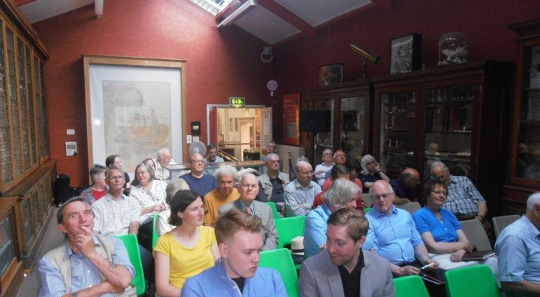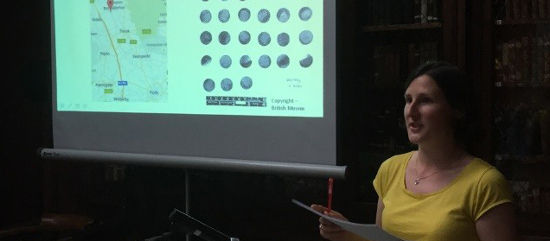by Andrew Woods
October 29, 2015 – On July 11, 2015, the Joint meeting of the Royal and British Numismatic Societies was hosted by the Yorkshire Numismatic Society in the Yorkshire Museum. The day was loosely focused on hoarding with a chronological range which spanned the Iron Age to the Seventeenth-century. Eight papers were delivered by speakers ranging from young scholars to established authorities. The day was attended by 42 people who were situated within the Yorkshire Museum’s historic library.
The audience awaits the days’ proceedings.
The event started with a brief welcome by Andrew Woods, introducing attendees to the Museum and the historic library in which they were sitting. Andrew Burnett (President, RNS) formally began proceedings with a welcome on behalf of the Royal Numismatic Society and chairing the first session.
The first session considered hoarding in the Iron Age and Roman periods with Philip de Jersey (Guernsey Museum & Art Gallery) and Eleanor Ghey (British Museum) tackling each respectively. Drawing upon his recently published book, Philip de Jersey focused on Northern British hoards, beginning by highlighting the relative paucity in the north when compared to southern England. He was able to highlight chronological variability and some geographic anomalies, for example hoards are preferentially buried on eastern slopes.
Eleanor Ghey introduces her paper on Roman hoards.
Eleanor Ghey summarized the aims and initial results of her on-going hoarding project, drawing together a colossal volume of data and trying to make sense of it. Amongst a number of insights was a comparison between hoards and single-finds of coins which shows that some of the unusually large numbers of Roman hoards from the third century can be partially explained by the vast quantities of coinage circulating at that time.
The second session shifted the focus to the Early Medieval period with Tony Abramson (University of York and President, YNS) considering the use of Anglian coinage in Northumbria. Marshalling a huge dataset, he was able to highlight some quite stark differences in the use of coinage within an early medieval kingdom, with certain parts of Northumbria showing earlier and more concentrated use of coinage. Andrew Woods (York Museums Trust) discussed the Vale of York Viking hoard, recently returned to the Yorkshire Museum. He gave preliminary results of a die-study and argued for the peaceful accumulation of much of the hoard: trade rather than raid.
Following an excellent lunch, sponsored by the Yorkshire Numismatic Society, attention turned to the medieval and early modern periods. Carl Savage reinterpreted the hoard from Bootham School in York. He was able to compare the coins in the hoard to other medieval hoards, arguing for it being a savings hoard but otherwise reflecting contemporary circulating currency. Barrie Cook (British Museum) considered the imagery of Stuart coins, highlighting the complex visual messages that coinage could convey. It represented something a king, or queen, could directly influence, something which was not lost on Stuart monarchs. He was able to show how monarchs manipulated the imagery on the coins for propagandist purposes, including James I modelling himself as warrior king in contrast to his predecessor Elizabeth.
Rachel Cubitt on the Warlaby hoard.
The final session of the day explored biographies of coinage across periods and what other things can be done to them. Rachel Cubitt (York Archaeological Trust) considered the hoard from Warlaby, North Yorks. She introduced the archaeological context of the tenth-century hoard, examined the types contained and also the secondary treatment of the hoards.
She was able to highlight the absence of Viking issues in the hoard and the possibility that the coins had been bent to test their purity. Matthew Ball (Harris Museum) considered the ‘Fleetwood’ hoard which contained hundreds of siliquae which had been identically scratched. He ruled out testing of the type common to the Viking age, preferring an explanation based upon varying weight standards in the post-Roman world.
Martin Allen (Fitzwilliam Museum and Editor, BNJ) closed the day, drawing some thoughts together and thanking the speakers and the various societies for their support. The day proved a success, much of which was due to an excellent set of speakers as well as an engaged and knowledgeable audience who kept the speakers on their toes with some tricky questions.
This news was first published in issue 65, 2015, of Money & Medals.
If you want to learn more about the British Numismatic Society, please click here.
Here you find the website of the Royal Numismatic Society.
And for information on the meeting’s venue, the Yorkshire Museum, please click here.







